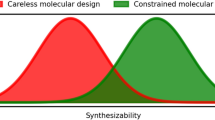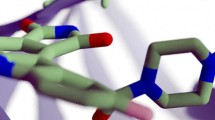Abstract
Genetic algorithms have properties which make them attractive in de novo drug design. Like other de novo design programs, genetic algorithms require a method to reduce the enormous search space of possible compounds. Most often this is done using information from known ligands. We have developed the ADAPT program, a genetic algorithm which uses molecular interactions evaluated with docking calculations as a fitness function to reduce the search space. ADAPT does not require information about known ligands. The program takes an initial set of compounds and iteratively builds new compounds based on the fitness scores of the previous set of compounds. We describe the particulars of the ADAPT algorithm and its application to three well-studied target systems. We also show that the strategies of enhanced local sampling and re-introducing diversity to the compound population during the design cycle provide better results than conventional genetic algorithm protocols.
Similar content being viewed by others
References
Walters, P.W., Stahl, M. and Murcko, M.A., Drug Des. Today, 3 (1998) 160.
Goodford, P.J., Med. Chem., 28 (1985) 849.
Miranker, A. and Karplus, M., Proteins, 11 (1991) 29.
Eisen, M.B., Wiley, D.C., Karplus, M. and Hubbard, R.E., Proteins, 19 (1994) 199.
Miranker, A. and Karplus, M., Proteins, 23 (1995) 472.
Pearlman, D.A. and Murcko, M.A., J. Med. Chem., 39 (1996) 1651.
Bohm, H.-J., J. Comput. Aid. Mol. Des., 6 (1992) 61.
Lauri, G. and Bartlett, P., J. Comput. Aid. Mol. Des., 8 (1994) 51.
Roe, D.C. and Kuntz, I.D., J. Comput. Aid. Mol. Des., 9 (1995) 269.
Lewis, R.A. and Leach, A.R., J. Comput. Aid. Mol. Des., 8 (1994) 467.
DeWitte, R. and Shakhnovich, E., J. Am. Chem. Soc., 118 (1996) 11733.
Bohacek, R.S. and McMartin, C., J. Am. Chem. Soc., 116 (1994) 5560.
Rotstein, S.H. and Murcko, M.A., J. Comput. Aid. Mol. Des., 7 (1993) 23.
Rotstein, S.H. and Murcko, M.A., J. Med. Chem., 36 (1993) 1700.
Moon, J.B. and Howe, W.J., Proteins, 11 (1991) 314.
Joseph-McCarthy, D., Pharmacol. Therapeut., 84 (1999) 179.
Lipinski, C.A., Lombardo, F., Dominy, B.W. and Feeny, P., J. Adv. Drug Del. Rev., 23 (1997) 3.
Schneider, G., Lee, M.-L., Stahl, M. and Schneider, P., J. Comput. Aid. Mol. Des., 14 (2000) 487.
Westhead, D.R., Clark, D.E., Frenkel, D., Li, J., Murray, C.W., Robson, B. and Waszkowycz, B., J. Comput. Aid. Mol. Des., 9 (1995) 139.
Glen, R.C. and Payne, A.W.R., J. Comput. Aid. Mol. Des., 9 (1995) 181.
Douguet, D., Thoreau, E. and Grassy, G., J. Comput. Aid. Mol. Des., 14 (2000) 449.
Devillers, J., J. Chem. Inf. Comput. Sci., 36 (1996) 1061.
Weber, L., Wallbaum, S., Broger, C. and Gubernator, K., Angew. Chem. Int. Ed. Engl., 34 (1995) 2280.
Blaney, J.M., Dixon, J.S. and Weininger, D., in Weininger, D. (Ed.), Molecular Graphics Society Meeting on Binding Sites: Characterising and Satisfying Steric and Chemical Restraints, York, U.K., 1993.
Sheridan, R.P. and Kearsley, S.K., J. Chem. Inf. Comput. Sci., 35 (1995) 310.
Sheridan, R.P., San Feliciano, S.G. and Kearsley, S.K., J. Mol. Graph. Model., 18 (2000) 320.
Holland, J.H., Adaptation in Natural and Artificial Systems, University of Michigan Press, Ann Arbor, MI, 1975.
Holland, J.H., Adaptation in Natural and Artificial Systems, 2nd ed., MIT Press, Cambridge, MA, 1992.
Darwin, C., The Origin of Species. Dent Gordon, London, 1973.
Weininger, D.J., Chem. Inf. Comput. Sci., 30 (1990) 237.
Daylight Toolkit, v. 4.6, Daylight Chemical Information Systems. Inc., Santa Fe, NM, USA.
Ewing, T.J. A. and Kuntz, I.D., J. Comp. Chem., 18 (1997) 1175.
CONCORD, Tripos, Inc., St. Louis, MO.
SYBYL, v6.5, Tripos, Inc., St. Louis, MO.
Kick, E.K., Roe, D.C., Skillman, G.A., Liu, G., Ewing, T.J.A., Sun, Y., Kuntz, I.D. and Ellman, J.A., Chem. Biol., 4 (1997) 297.
Queener, S.F., Bartlett, M.S., Jay, M.A., Durkin, M.M. and Smith, J.W. Antimicrobiol. Agents Chemother., 31 (1987) 1323.
Bertino, J.R., J. Clin. Pharmacol., 30 (1990) 291.
Blaney, J.M., Hansch, C., Silipo, C. and Vittoria, A., Chem. Rev., 84 (1984) 333.
Verkhivker, G.M., Rejto, P.A., Bouzida, D., Arthurs, S., Colson, A.B., Freer, S.T., Gehlhaar, D.K., Larson, V., Luty, B.A., Marrone, T. and Rose, P., J. Mol. Recog., 12 (1999) 371.
De Clerq, E., Antiviral Res., 38 (1998) 153.
Ding, J., Das, K., Moereels, H., Koymans, L., Andries, K., Janssen, P.A., Hughes, P.A. and Arnold, E., Nat. Struct. Biol., 2 (1995) 407.
Ferrin, T.E., Huang, C.C., Jarvis, L.E. and Langridge, R., J. Mol. Graph., 6 (1988) 13.
Artico, M., Il Farmaco, 51 (1996) 305.
Goldberg, D.E., in Schaffer, J.D. (Ed.), Third International Conference on Genetic Algorithms. Morgan Kaufmann, Fairfax, VA, 1989, pp. 70.
Grefenstette, J., J. IEEE Transactions Systems, Man, and Cybernetics, 16 (1986) 122.
Schaffer, J.D., Caruana, R.A., Eshelman, L.J. and Das, R., in Schaffer, J.D. (Ed.), Third International Conference on Genetic Algorithms. Morgan Kaufmann, Fairfax, VA, 1989, pp. 51.
Caflisch, A. and Karplus, M., Persp. Drug Disc. Design, 3 (1995) 51.
Zou, X. Q., Sun, Y. and Kuntz, I.D., J. Am. Chem. Soc., 121 (1999) 8033.
Author information
Authors and Affiliations
Rights and permissions
About this article
Cite this article
Pegg, S.CH., Haresco, J.J. & Kuntz, I.D. A genetic algorithm for structure-based de novo design. J Comput Aided Mol Des 15, 911–933 (2001). https://doi.org/10.1023/A:1014389729000
Issue Date:
DOI: https://doi.org/10.1023/A:1014389729000




